Articles Menu
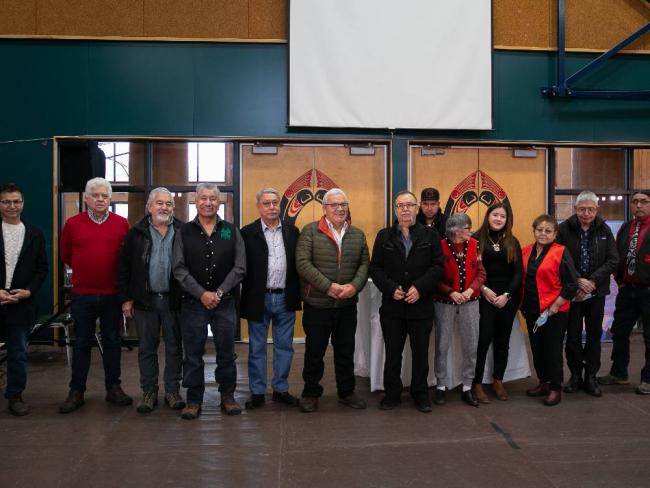
Dec. 11, 2022
It was sometime after midnight on a winter night in 1988 that Simogyet (Chief) Neekt took his farm tractor and dragged a log across the Kispiox Valley Road.
About a dozen others were there from Kispiox Village, a Gitxsan community of about 500 people nestled at the confluence of the Skeena and Kispiox rivers in northwest B.C. Tired of the lumbering logging trucks that continually rolled through the village hauling timber to mills farther and farther afield — taking not just the resources but the jobs that went with them — they built a large bonfire on the road and dug in.
Neekt, who also goes by George Muldoe, wasn’t there when the logging trucks arrived early that morning. But he knows what happened next. “Lots of swearing at Indians,” he says, decades later, sitting at the kitchen table with his son, Hup Wil Lax A, Kirby Muldoe. “Even the Indians were swearing at the Indians because some of them had trucks.”
As the standoff got underway, a groundbreaking court case was picking up steam in a Vancouver courtroom nearly 1,000 kilometres to the south. While the Kispiox blockade — one of several that sprung up during that time — would only last a short while, it would take almost a decade for the Gitxsan and their neighbours, the Wet’suwet’en, to get a decision from the Supreme Court of Canada that would change the course of Indigenous rights in Canada.
It also recorded a library’s worth of testimony from Wet’suwet’en and Gitxsan Elders who retained a direct link to their culture before colonization. While most of these Elders have since passed, their words are preserved for future generations — and as evidence, should the nations ever return to court.
But for the Gitxsan and Wet’suwet’en, Delgamuukw, as it’s colloquially known, took its toll. The years of laying out their culture and traditions before what was, at times, an unsympathetic court left an open wound and a question unanswered: What would the Supreme Court of Canada’s recognition of Indigenous rights and title mean for the people who fought it?
“It changed things worldwide, but not locally,” says Neekt, who is in line to take the hereditary name Delgamuukw at a headstone feast, a ceremony held a year after a name-holder’s passing, planned for spring. “The provincial and federal governments’ heels are dragging. They don’t want change.”
As the court case got underway all those decades ago, logging on the territory ramped up, he says, with a logging truck full of timber leaving the territory every 45 seconds in the years their case was before the courts.
It has continued unabated, with other industries also receiving provincial approval. Neekt’s steady gaze occasionally flits to a clock on the wall. He doesn’t want to be late for a last-minute Chiefs’ meeting called to discuss pipelines proposed for the territories.
“To me, reconciliation’s all bullshit,” he says, his index finger thumping the kitchen table. “You can put that in there.”
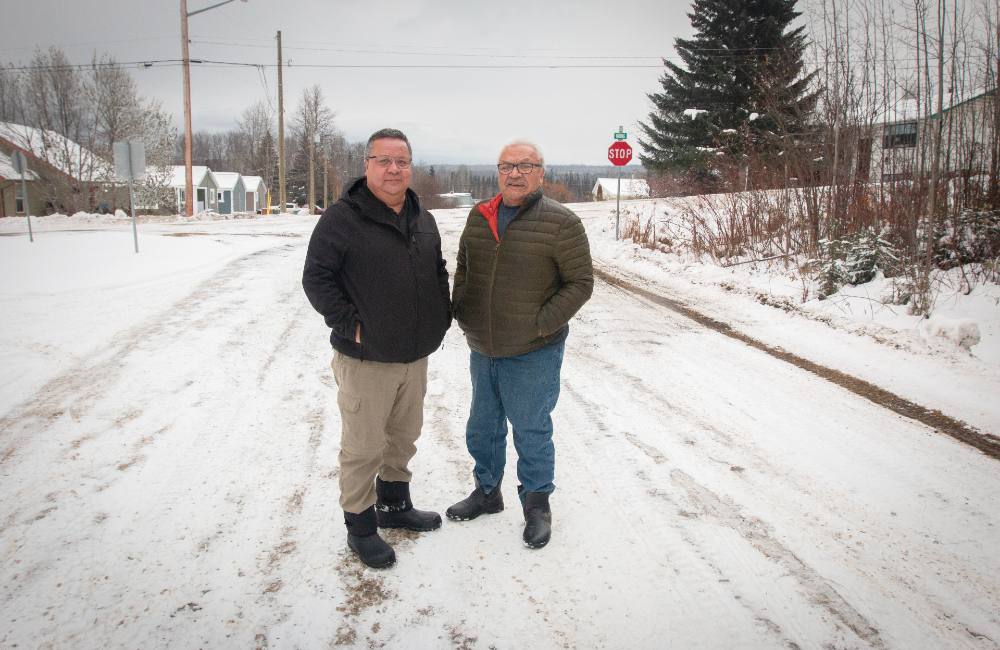
Over the last 25 years, a new generation of hereditary leaders has stepped into the roles held by those who took the case all the way to the Supreme Court of Canada.
As many of them gathered on Gitxsan and Wet’suwet’en territories to celebrate this past weekend, they honoured the Elders and Chiefs who forged a new path for Indigenous rights and they emphasized their connection to the land — the Gitxsan laxyip and Wet’suwet’en yintah — as the foundation of their cultures.
They pointed to the youth, many of whom gathered at a celebration held in the Wet’suwet’en community of Witset on Friday, as the main reason to continue the fight and they talked about the need for unity as they move forward.
“It’s up to us now to keep Delgamuukw-Gisday’wa alive,” said Dinize (Hereditary Chief) Wigitimst’ochl, Victor Jim, who acted as a Wet’suwet’en translator during the trial.
“I know we’ve still got lots of work to do. It’s been mentioned over and over again that we need to come back together and become strong again. We can do it. We did it once and we can do it again.”
The evidence: adwaak and kungax
It was with some trepidation that the Elders opened their “history box” to the courts all those years ago, Wet’suwet’en Dinize Satsan says.
“Their fear was that our histories wouldn’t be respected and that they would be dirtied,” he says. But the Elders also realized the value in recording their stories. “They said, ‘If we do this, and write it down, it won’t be lost for future generations.’”
Satsan, who also goes by Herb George, had returned to his home community of Hagwilget in 1975 after finishing residential school at Prince George College. The village of about 200 residents is made up of both Wet’suwet’en and Gitxsan members — a unique manifestation of the two nations’ long-standing allyship.
As the local band manager, Satsan began working with both the Gitxsan and Wet’suwet’en Chiefs in their battles over things like fishing rights, logging and attempts by the province to flood more of the territory for a hydroelectric project. While the Chiefs won some cases on legal or procedural technicalities, the overriding question of who had jurisdiction over the territories remained unanswered.
“Finally, our Chiefs respectively, the Gitxsan and the Wet’suwet’en, realized that we had to take this action to the courts,” he says. “So, we got busy.”
A statement of claim was filed at the B.C. Supreme Court in fall 1984 and the nations got to work gathering evidence, Oral Histories known to the Gitxsan as adwaak and the Wet’suwet’en as kungax. It would take them two years.
The team supporting the Chiefs devised a unique strategy: Rather than leaning on so-called expert testimony — the outside perspectives of anthropologists, sociologists, linguists and ecologists — it was the Chiefs’ testimony, the adwaak and kungax, that would provide the backbone of their argument.
“A lot of the Chiefs were reluctant to go to court,” Hup Wil Lax A says. “They were scared. And Albert [Tait, Delgamuukw] said, ‘What are you afraid of? You’ve got the truth. Just go in there and tell the truth.’”
The trial began in Smithers, B.C., on May 11, 1987. Evidence was given in the Gitxsan and Wet’suwet’en languages, with the nations training translators to interpret for B.C. Supreme Court Judge Allen McEachern.
The volume of evidence soon made it clear that the trial would last longer than expected. After several months on Wet’suwet’en territory, McEachern adjourned and moved the trial to Vancouver, where it resumed in January 1988. In total, the court heard 374 days of evidence, with final arguments returning to Smithers in June 1990.
“It was a tremendous strain on the people,” says lawyer Richard Overstall, who worked as an intermediary between the Chiefs, lawyers and expert witnesses during the case. Witnesses were subjected to taxing cross-examination by government lawyers and costs mounted with the travel to Vancouver.
When the decision came down, it confirmed the Elders’ fears that their adwaak and kungax would not be respected.
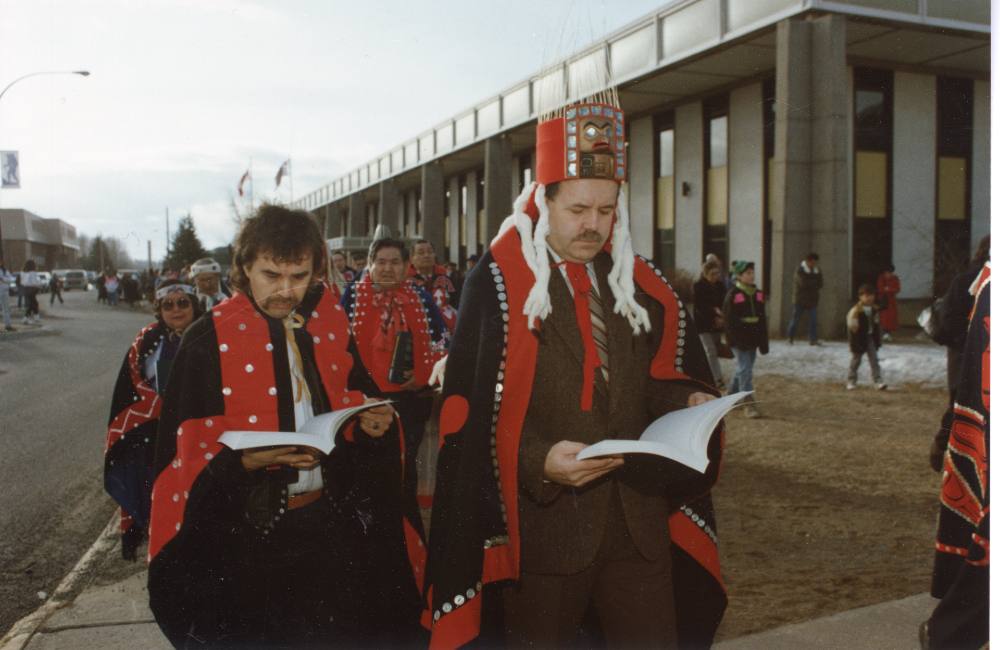
McEachern’s words have infamously become a stunning reminder of the callous indifference he showed to the sacred stories Gitxsan and Wet’suwet’en Elders so carefully packaged and laid bare before the court. In his March 1991 decision, the chief justice rejected most of the oral evidence as hearsay, calling the Wet’suwet’en and Gitxsan “a primitive people” for their lack of written language, horses and wheeled vehicles.
The decision, at almost 400 pages, wrote off traditional life on the territory as “nasty, brutish and short.” McEachern concluded that Indigenous rights exist at the “pleasure of the Crown” and that, as such, they could be extinguished by the Crown.
The decision came as a blow.
“McEachern, in his decision, said that we weren’t sufficiently civilized to have our own laws and, at best, that they were customs,” says Satsan, who acted as strategist and speaker for the nations throughout the legal process. “Of course, we came out of the Supreme Court turning that around.”
‘We changed history’
The outrageousness of McEachern’s decision left the Gitxsan and Wet’suwet’en with little choice but to appeal, Overstall says — not just for the two nations’ sake, but for Indigenous groups across Canada.
As the team prepared its argument for the Supreme Court of Canada, it began to rethink its approach, Satsan says.
“I came back to them and said, ‘If we don’t change our arguments, we’re going to lose,’” he remembers. “So, they gave me direction to change the argument.”
The new argument they presented to the Supreme Court of Canada was not for ownership, which was misunderstood by the courts as a fight for fee simple, but for Aboriginal title, something legally considered “sui generis” and unique.
The appeal was heard at a two-day hearing in Ottawa in June 1997. The decision arrived six months later. It affirmed both that Oral Histories could be used as evidence, and that Wet’suwet’en and Gitxsan title had not been extinguished.
“It is inalienable and cannot be transferred, sold or surrendered to anyone other than the Crown,” it said. “Finally, Aboriginal title is held communally.”
The decision was historical, Satsan says.
“We changed the law, we created new law, and we changed the constitution and we defined it,” he says. “We changed history.”
Because McEachern had rejected most of the original testimony, the Supreme Court of Canada reluctantly ordered a new trial — but also cautioned against it, saying litigation had been “both long and expensive, not only in economic but in human terms as well.” Instead, it encouraged the parties to negotiate an agreement.
While the decision was considered a victory, it came at a cost to the Wet’suwet’en and the Gitxsan. “That spiritual toll on our people was something that people don’t think about. It was immense, and we’re still trying to get up from it,” Satsan says.
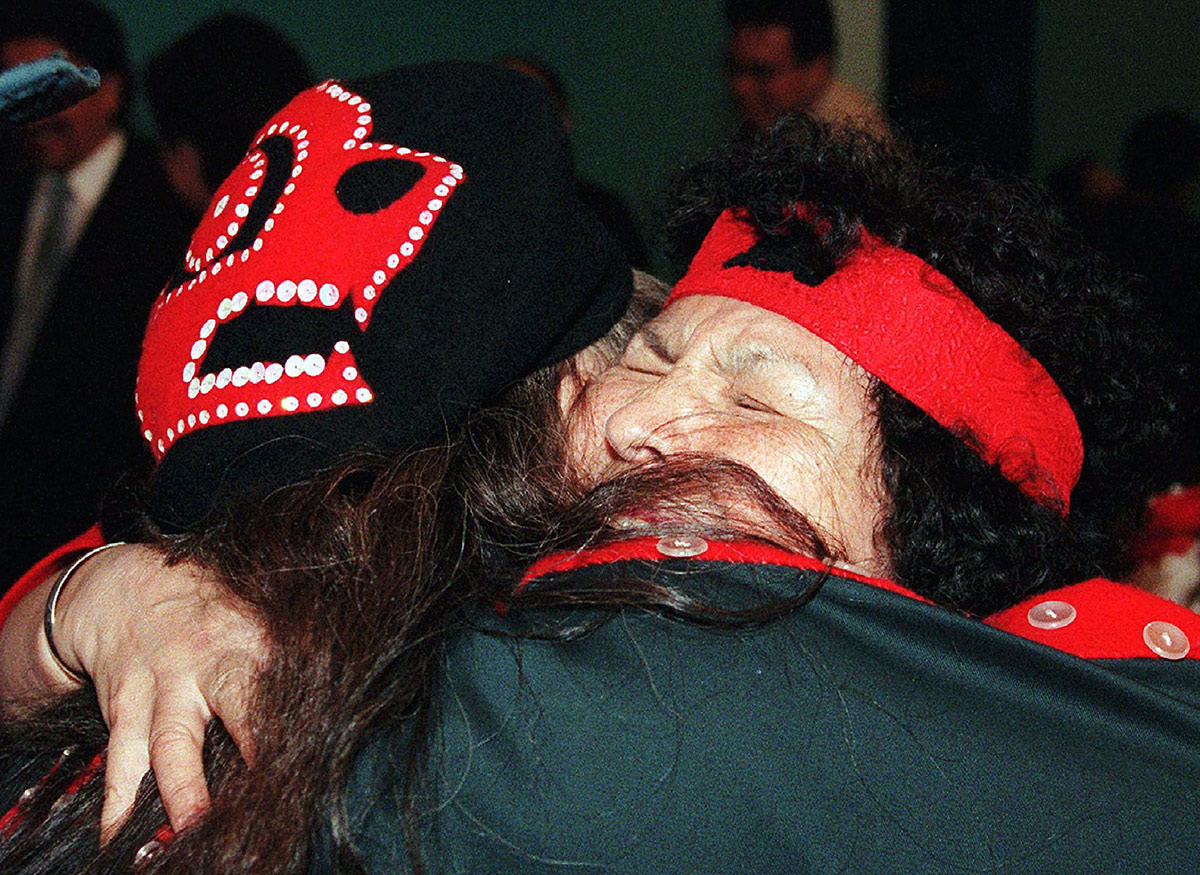
After more than a decade going through the courts, overturning McEachern’s decision brought elation and relief, Overstall says. There was a sense that the nations had won and, in the aftermath, an assumption that B.C. and Canada would be compelled to deal with them more fairly.
“They didn’t,” Overstall says. “And they still don’t.”
By the time the Supreme Court decision came down, Overstall was a law student at the University of Victoria. He joined the negotiating team that attempted to move the Delgamuukw decision forward in the years that followed. But he says the provincial government took the “most ungenerous” reading of the decision and negotiations soon fell off.
“Legally, it was a huge step forward,” Overstall says. “On the ground, not so much for the Wet’suwet’en and Gitxsan people.”
Recognition of traditional governance
Wet’suwet’en Dinize Na’Moks was a young man in his 30s as the case went through the courts. Though he was often away, working as a commercial fisher on the coast, he was at home in Telkwa with his grandmother — who at that time held the name Na’Moks — when the Supreme Court of Canada decision came down.
Na’Moks, who also goes by John Ridsdale, remembers the racism and rumours that swirled in its aftermath as people feared they would be pushed from their properties and homes.
“It was just a terrible ordeal for our Elders and Chiefs to go through,” he says. “There were lots of tears, lots of joy, too. But for them to be that strong and continue — it was absolutely an uphill battle, because there’s never been a court case like it in the history of British Columbia or Canada, ever.”
But the nations didn’t intend to displace anyone. What they were fighting for was recognition of their traditions and who they are as a people, he says. As such, the decision to use hereditary names was an important one.
When Delgamuukw, then Albert Tait, and Gisday’wa, then Alfred Joseph, filed their claim in 1984, it was on behalf of the Wet’suwet’en and Gitxsan people, respectively. In total, there were 54 plaintiffs, all hereditary name holders, fighting for jurisdiction over roughly 58,000 square kilometres of territory in northwest B.C.
Joseph would carry the Gisday’wa name throughout the trial and until his death in January 2014 at age 86, when it would pass to Fred Tom.
Delgamuukw would pass between several people during the trial — from Tait, who died in 1987, to Ken Muldoe, and then to Earl Muldoe, who is named in the 1997 supreme court decision. With Earl’s passing nearly a year ago, his brother, Neekt, is in line to take the name.
While the people pass, the names live on — just as they have for thousands of years.
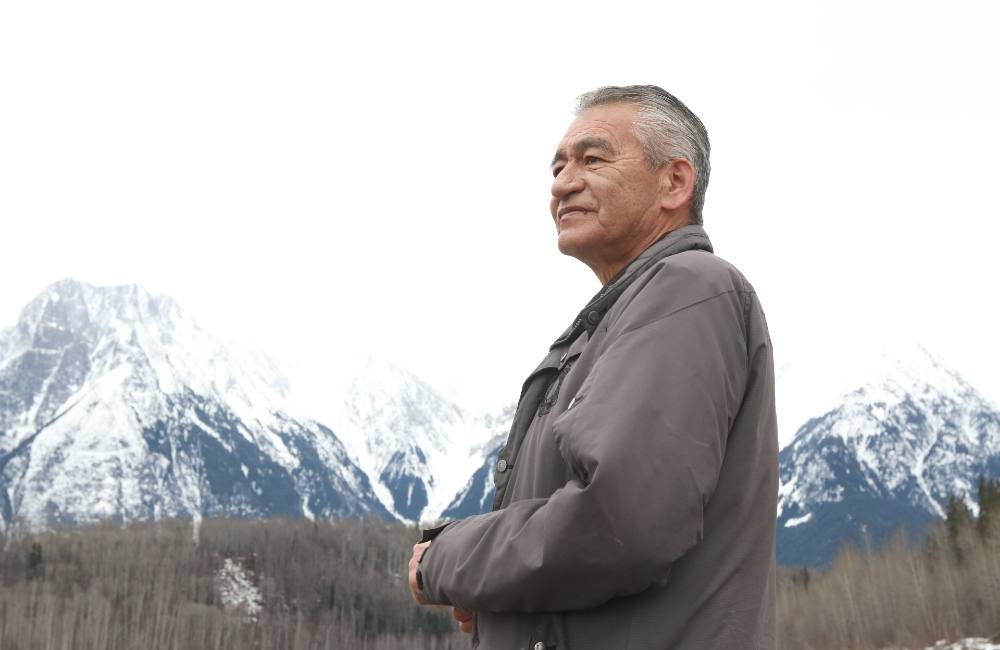
At the heart of this system is accountability and transparency, Satsan says. Business is conducted in the feast hall and witnessed by all the clans. While the system is frequently misconstrued as an autocracy, it’s in fact the opposite — strategic direction comes from the people, he says.
“It was led by our Chiefs, representing our people. That is very, very important,” Satsan says. “Because the foundation of our respective systems of government — the potlatch, our clan and house system — is that the title and rights, and the inherent rights that we’re talking about, belong collectively and communally to our people.”
‘They’re dividing the people’
Twenty-five years later, logging trucks continue to rumble up the Kispiox Valley. “It’s still going full bore,” Neekt says.
Other industries have also arrived. For more than a decade, Wet’suwet’en Hereditary Chiefs have opposed proposed pipelines through their traditional territory. That hasn’t stopped one project, the Coastal GasLink pipeline, from pushing ahead.
In granting an injunction to the pipeline company in 2019, B.C. Supreme Court Justice Marguerite Church dismissed the Delgamuukw decision, saying, “The Aboriginal title claims of the Wet’suwet’en remain outstanding and have not been resolved either by litigation or negotiation, despite the urging of the Supreme Court of Canada in Delgamuukw.”
In the years since, RCMP have conducted several high-profile police actions and made dozens of arrests under the injunction. Gitxsan hereditary leaders have stood by their traditional allies, with arrests also taking place as a result of rail blockades on the neighbouring territory.
Three additional pipelines are slated for the nations’ territories. The province recently declined to answer The Tyee’s questions about whether it would support the projects.
While government and industry have pointed to impact benefit agreements signed with First Nations band councils as evidence of support for the pipelines, it wasn’t the band councils that fought Delgamuukw-Gisday’wa.
“What the pipelines are doing… they’re dividing the people with money,” Neekt says. “There’s a couple of good examples locally where they funded the band councils. The band council has no right outside the reserves. None whatsoever.”
In early 2020, after a month-long standoff and a five-day police action on Wet’suwet’en territory, it appeared the work left undone after Delgamuukw-Gisday’wa might finally resume.
B.C., Canada and Wet’suwet’en hereditary leadership signed a memorandum of understanding recognizing that Wet’suwet’en rights and title are “held by Wet’suwet’en Houses under their system of governance.”
The governments committed to coming to an agreement over Wet’suwet’en rights and title in the year that followed. But that hasn’t happened.
Na’Moks says the discussions stalled when governments insisted that band councils — a construct of the Canadian government under the Indian Act — sit at the bargaining table.
“They’ve reverted right back to the thought process pre-Delgamuukw,” he says. “They are picking and choosing who they will talk to. Meanwhile, the Supreme Court of Canada says, when it comes to the Gitxsan and the Wet’suwet’en, you must talk to the Hereditary Chiefs.”
A living legacy
Satsan’s life work was crystalized on Dec. 11, 1997. Today, he travels the world with the Centre for First Nations Governance, an organization he founded to help Indigenous groups across Canada and as far away as New Zealand apply the Delgamuukw decision.
“That’s the legacy of Delgamuukw and Gisday’wa and it’s a living legacy,” he says.
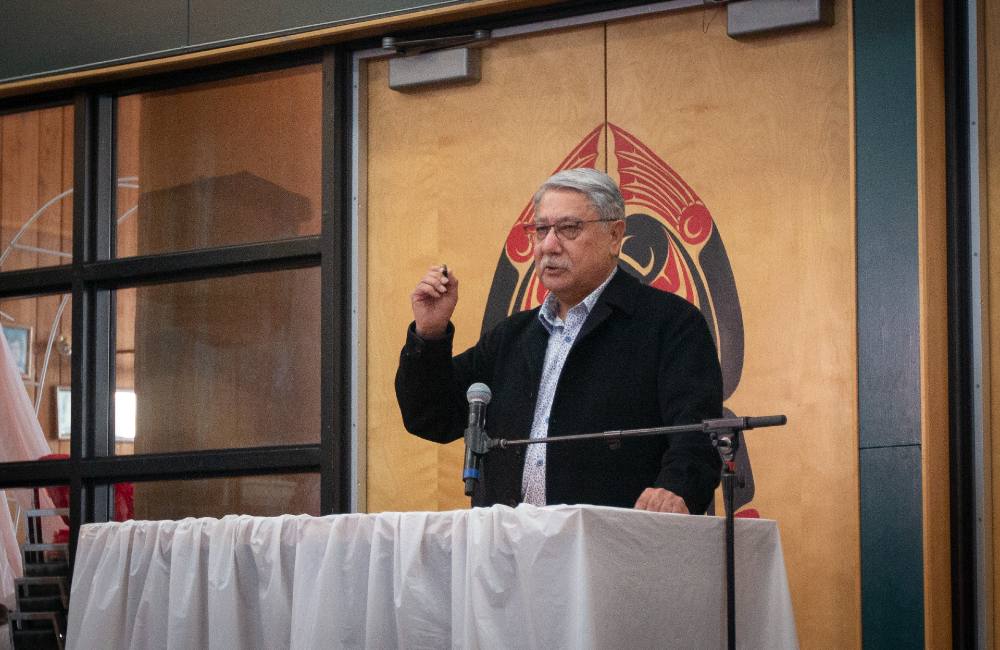
Other nations have moved Delgamuukw forward with their own court cases.
It was cited when the B.C. Supreme Court upheld the Nisga’a Treaty in 2000. It was used again in 2004 when the Supreme Court of Canada affirmed B.C.’s duty to consult the Haida Nation and again, the year after, when Mikisew Cree First Nation successfully fought for hunting rights.
But of the many cases that applied Delgamuukw over the past quarter century, it was the 2014 Tsilhqot’in Nation v. British Columbia that galvanized its intention, Satsan says.
“It applied the law that we created on Delgamuukw and Gisday’wa,” he says. “What resulted from it was the first declaration of Aboriginal title and rights on the ground.”
Some believe the nations should return to court and finish what was started with Delgamuukw-Gisday’wa. Among those gathered in Witset on Friday, many Chiefs called for the nations to take their fight back to the legal system.
Neekt, the next Delgamuukw, says he would support the move.
“My preference would be to go back to court, personally,” he says. “The judge said that, ‘We have opened the doors for you. The rest is up to you.’ We haven’t walked through those doors yet.”
Satsan doesn’t believe returning to court is necessary. He says the Indigenous rights cases that came in the wake of Delgamuukw have laid the groundwork for the Wet’suwet’en and Gitxsan to successfully assert title over their territories.
All the pieces are there. The nations just need to decide how to move ahead, he says.
“The immediate next step is reconciliation amongst ourselves,” Satsan says. “We lost that generation of leaders, both the Wet’suwet’en and the Gitxsan, and we’re still struggling with that.
“We have to rebuild our system of governance and we’ve got to get back to the original vision of our Chiefs and leaders and people who brought us there.”
[Top photo: Many of those who fought the historic Deglamuukw-Gisday’wa gathered in the Wet’suwet’en community of Witset on Friday to celebrate. ‘We’ve got to get back to the original vision of our Chiefs and leaders and people who brought us there,’ says Wet’suwet’en Dinize Satsan, Herb George. Photo by Olivia Leigh Nowak.]